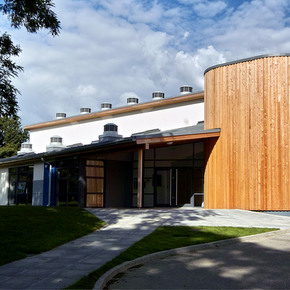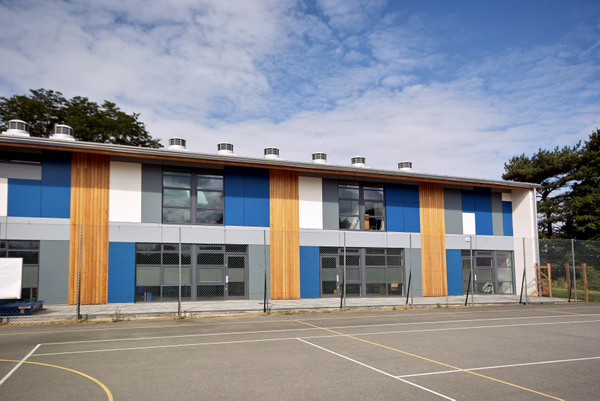
Passive ventilation solution manufactured in the UK
GUEST BLOG: Thomas Lipinski, Technical Director, Ventive Ltd looks at the role of passive ventilation systems in schools.
UK schools spending £159m per year on heating according to RIBA. However, there is a growing realisation in the construction industry that complex mechanical ventilation systems are a recipe for disaster for schools.
As part of a recent report by the Royal Institution of British Architects (RIBA), 129 UK schools’ post-occupancy evaluations were analysed. It revealed a large number of technical ventilation devices were being disabled or abandoned having been deemed too burdensome for the school to manage. Problems included excessive electrical energy consumption, high base loads and lack of controllability, leading to overheating and discomfort.
Designers are taking a modern holistic approach to school building design to enhance energy efficiency and improve the learning environment whilst engineers are rapidly coming round to the idea that natural ventilation systems are a reliable, cost-effective option to the mechanical alternative.
Until recently, natural ventilation systems were known for two things – providing ventilation without electricity use and reducing overheating during warmer weather. The problem was they couldn’t recover heat when it turns colder.
For our children to succeed at school, the building itself needs to perform as well as the staff and students. A good reason, then, for architects and contractors alike to consider the benefits of systems such as the Ventive C900.
Passive ventilation system Case Study

Installation of Ventive C900 passive ventilation for the Cullum Centre at Salesian School in Chertsey, Surrey.
Richardson and Peat carried out the first installation of Ventive C900 at £1.2 million Cullum Centre at Salesian School in Chertsey, Surrey, a pioneering centre to help autistic children into mainstream education.
The building’s design needed to maximise energy efficiency. The Ventive C900took two years to develop system and consists of a roof cowl, eleven of which were installed at the Cullum Centre, one per room. As well as being easy to install and negating the need for PV roof installation (due to the building achieve required energy savings with demand reduction alone), the system is a simple and effective operator.
In colder weather, warm air inside the building is driven through the heat exchanger where it naturally warms up a supply of outside air on its way to the classroom. In spring and summer months the roof cowl works like a small wind collector, ensuring rooms remain naturally ventilated at all times.
On average, it is estimated Ventive C900 will reduce a school’s energy costs by £350 per year (per classroom).
Latest news

26th July 2024
Enfield Speciality Doors completes world-class project for Atlas Copco HQ
A rundown office and warehouse building completely transformed into a modern headquarters for Atlas Copco has been fitted with more than 120 internal fire doors from Enfield Speciality Doors.
Posted in Access Control & Door Entry Systems, Articles, Building Industry News, Building Products & Structures, Building Systems, Case Studies, Doors, Interior Design & Construction, Interiors, Posts, Restoration & Refurbishment, Retrofit & Renovation, Security and Fire Protection, Sustainability & Energy Efficiency, Timber Buildings and Timber Products, Wooden products
26th July 2024
Abloy UK launches new white paper
Abloy UK, a leading provider of security and access control solutions, has launched a new white paper.
Posted in Access Control & Door Entry Systems, Architectural Ironmongery, Articles, Building Industry News, Building Products & Structures, Building Services, Doors, Facility Management & Building Services, Health & Safety, Information Technology, Innovations & New Products, Publications, Research & Materials Testing, Security and Fire Protection
26th July 2024
MCRMA Member Profile: David Roy, Director of Roofconsult
David Roy of MCRMA member company Roofconsult has more than 50 years’ experience to draw upon working in the building envelope sector and a unique perspective on how it has changed in that time.
Posted in Articles, BIM, Infrastructure & CAD Software, Building Associations & Institutes, Building Industry News, Building Products & Structures, Building Services, Building Systems, Cladding, Information Technology, Restoration & Refurbishment, Retrofit & Renovation, Roofs, Walls
26th July 2024
Strand: Enhancing Door Functionality and Safety
Craig Fox, Sales Director for Strand Hardware, outlines how door industry professionals might apply door limiting stays…
Posted in Architectural Ironmongery, Articles, Building Industry News, Building Products & Structures, Building Services, Doors, Facility Management & Building Services, Health & Safety, Restoration & Refurbishment, Retrofit & Renovation
 Sign up:
Sign up: